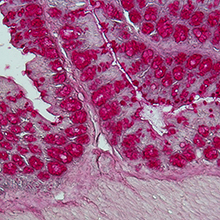

The intestinal microbiota (shown here is a histological staining of a colon section) is significantly influencing the immune system of the host.
Source: Dr. Caspar Ohnmacht, ZAUM
Scientists at Helmholtz Zentrum Munich, at the Technical University of Munich (TUM), and Institut Pasteur in Paris have succeeded in explaining this phenomenon, and demonstrate how the microbiota acts on the balance of the immune system: the presence of microbes specifically blocks the immune cells responsible for triggering allergies. These results are published in Science.
The hygiene hypothesis suggests a link between the decline in infectious diseases and the increase in allergic diseases in industrialized countries. Improvements in hygiene levels necessarily lead to reduced contact with microbes that is paralleled by an increased incidence in allergic and autoimmune diseases, such as type 1 diabetes.
Epidemiological studies have substantiated this hypothesis, by showing that children living in contact with farm animals – and therefore with more microbial agents – develop fewer allergies during their lifetime. Conversely, experimental studies have shown that administering antibiotics to mice within the first days of life results in a loss of microbiota, and subsequently, in an increased incidence in allergy. However, until now, the biological mechanisms underlying this phenomenon remained unclear.
Microbiota is essential for preventing allergies
In this study published in Science, the team around Dr. Caspar Ohnmacht at Center of Allergy and Environment (ZAUM) of Technical University of Munich and Helmholtz Zentrum Munich and around Gérard Eberl, head of the Microenvironment and Immunity Unit at the Institut Pasteur, shows that, in mice, symbiotic intestinal microbes act on the immune system by blocking allergic reactions.
Several types of immune response can be generated in order to defend the organism. The presence of bacterial or fungal microbes provokes a response from immune cells known as type 3 cells. These immune cells coordinate the phagocytosis and killing of the microbes.
However, in the case of infection by pathogenic agents that are too large to be handled by type 3 cells (such as parasitic worms and certain allergens), the cells that organize the elimination of the pathogen, but also allergic reactions, are known as type 2 cells.
In this study, scientists at the Institut Pasteur have shown that type 3 cells activated during a microbial aggression act directly on type 2 cells and block their activity. Type 2 cells are consequently unable to generate allergic immune responses. This work demonstrates that the microbiota indirectly regulates type 2 immune responses by inducing type 3 cells.
These results explain how an imbalance in microbiota triggers an exaggerated type 2 immune response normally used to fight large parasites, but that also leads to allergic responses. Ohnmacht summarizes: “These findings represent an important milestone in understanding the balance between our various defense mechanisms. In terms of allergy treatment, a hitherto unexplored therapeutic approach consists therefore in stimulating type 3 cells by mimicking a microbial antigen in order to block allergy-causing type 2 cells.”
Further Information
Background:
These studies were funded by the French National Agency for Research, the French Medical Research Foundation, the Simone & Cino Del Duca Foundation, the European Commission and the “Integrative Biology of Emerging Infectious Diseases” Laboratory of Excellence. During the study, Caspar Ohnmacht was supported by an EMBO longterm fellowship
Original Publication:
Ohnmacht, C. et al. (2015). The microbiota regulates type 2 immunity through RORt+ T cells, Science, DOI: 10.1126/science.aac4263
As German Research Center for Environmental Health, Helmholtz Zentrum München pursues the goal of developing personalized medical approaches for the prevention and therapy of major common diseases such as diabetes mellitus and lung diseases. To achieve this, it investigates the interaction of genetics, environmental factors and lifestyle. The Helmholtz Zentrum München has about 2,300 staff members and is headquartered in Neuherberg in the north of Munich. Helmholtz Zentrum München is a member of the Helmholtz Association, a community of 18 scientific-technical and medical-biological research centers with a total of about 37,000 staff members.
The Center of Allergy & Environment (ZAUM) in Munich is a joint undertaking by the Helmholtz Zentrum München and the Technical University of Munich (TUM). This cooperation, which is the only one of its kind in the German research landscape, is dedicated to interdisciplinary basic research and forms a link between clinicians at the hospital and clinical research staff at the university. Thanks to this approach, findings about the mechanisms that lie behind allergies are translated into preventive and therapeutic measures. The development of effective, individually tailored treatments enables better care to be provided for allergy-sufferers. www.zaum-online.de
Technische Universität München (TUM) is one of Europe’s leading research universities, with around 500 professors, 10,000 academic and non-academic staff, and 36,000 students. Its focus areas are the engineering sciences, natural sciences, life sciences and medicine, reinforced by schools of management and education. TUM acts as an entrepreneurial university that promotes talents and creates value for society. In that it profits from having strong partners in science and industry. It is represented worldwide with a campus in Singapore as well as offices in Beijing, Brussels, Cairo, Mumbai, and São Paulo. Nobel Prize winners and inventors such as Rudolf Diesel and Carl von Linde have done research at TUM. In 2006 and 2012 it won recognition as a German “Excellence University.” In international rankings, it regularly places among the best universities in Germany.
Contact for the media:
Department of Communication, Helmholtz Zentrum München – German Research Center for Environmental Health (GmbH), Ingolstädter Landstr. 1, 85764 Neuherberg – Phone: +49 89 3187 2238 – Fax: +49 89 3187 3324 – E-mail: presse@helmholtz-muenchen.de
Scientific contact at Helmholtz Zentrum München:
Dr. Caspar Ohnmacht, Helmholtz Zentrum München – Deutsches Forschungszentrum für Gesundheit und Umwelt (GmbH), Zentrum Allergie und Umwelt (ZAUM), Ingolstädter Landstr. 1, 85764 Neuherberg – Tel. +49 89 3187 2556 – E-mail: caspar.ohnmacht@tum.de
http://www.sciencemag.org/content/early/2015/07/08/science.aac4263.abstract – Link to the Publication
http://www.helmholtz-muenchen.de/en/index.html – Website Helmholtz Zentrum München
http://www.zaum-online.de/ – Website Center of Allergy & Environment (ZAUM)















